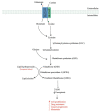Role of SLC7A11/xCT in Ovarian Cancer
- PMID: 38203758
- PMCID: PMC10779187
- DOI: 10.3390/ijms25010587
Role of SLC7A11/xCT in Ovarian Cancer
Abstract
Ovarian cancer is one of the most dangerous gynecologic cancers worldwide and has a high fatality rate due to diagnosis at an advanced stage of the disease as well as a high recurrence rate due to the occurrence of chemotherapy resistance. In fact, chemoresistance weakens the therapeutic effects, worsening the outcome of this pathology. Solute Carrier Family 7 Member 11 (SLC7A11, also known as xCT) is the functional subunit of the Xc- system, an anionic L-cystine/L-glutamate antiporter expressed on the cell surface. SLC7A11 expression is significantly upregulated in several types of cancers in which it can inhibit ferroptosis and favor cancer cell proliferation, invasion and chemoresistance. SLC7A11 expression is also increased in ovarian cancer tissues, suggesting a possible role of this protein as a therapeutic target. In this review, we provide an overview of the current literature regarding the role of SLC7A11 in ovarian cancer to provide new insights on SLC7A11 modulation and evaluate the potential role of SLC7A11 as a therapeutic target.
Keywords: SLC7A11; chemoresistance; compounds; non-coding RNAs; nuclear factor erythroid 2-related factor 2 (NRF2); ovarian cancer; oxidative stress; p53; reactive oxygen species (ROS); xCT.
Conflict of interest statement
The authors declare no conflicts of interest.
Figures


Similar articles
-
Cystine-glutamate antiporter xCT as a therapeutic target for cancer.Cell Biochem Funct. 2021 Mar;39(2):174-179. doi: 10.1002/cbf.3581. Epub 2020 Aug 4. Cell Biochem Funct. 2021. PMID: 32749001 Review.
-
The glutamate/cystine antiporter SLC7A11/xCT enhances cancer cell dependency on glucose by exporting glutamate.J Biol Chem. 2017 Aug 25;292(34):14240-14249. doi: 10.1074/jbc.M117.798405. Epub 2017 Jun 19. J Biol Chem. 2017. PMID: 28630042 Free PMC article.
-
Rotavirus-induced lncRNA SLC7A11-AS1 promotes ferroptosis by targeting cystine/glutamate antiporter xCT (SLC7A11) to facilitate virus infection.Virus Res. 2024 Jan 2;339:199261. doi: 10.1016/j.virusres.2023.199261. Epub 2023 Nov 14. Virus Res. 2024. PMID: 37923170 Free PMC article.
-
Amino acid transporter SLC7A11/xCT at the crossroads of regulating redox homeostasis and nutrient dependency of cancer.Cancer Commun (Lond). 2018 Apr 25;38(1):12. doi: 10.1186/s40880-018-0288-x. Cancer Commun (Lond). 2018. PMID: 29764521 Free PMC article. Review.
-
Cystine transporter SLC7A11/xCT in cancer: ferroptosis, nutrient dependency, and cancer therapy.Protein Cell. 2021 Aug;12(8):599-620. doi: 10.1007/s13238-020-00789-5. Epub 2020 Oct 1. Protein Cell. 2021. PMID: 33000412 Free PMC article. Review.
Cited by
-
Modulation of NRF2/KEAP1 Signaling by Phytotherapeutics in Periodontitis.Antioxidants (Basel). 2024 Oct 18;13(10):1270. doi: 10.3390/antiox13101270. Antioxidants (Basel). 2024. PMID: 39456522 Free PMC article. Review.
-
Icariside II induces ferroptosis through the down-regulation of SLC7A11 in ovarian cancer.J Ovarian Res. 2025 Apr 5;18(1):71. doi: 10.1186/s13048-025-01650-1. J Ovarian Res. 2025. PMID: 40186304 Free PMC article.
-
Single-nucleus RNA-seq dissection of choroid plexus tumor cell heterogeneity.EMBO J. 2024 Dec;43(24):6766-6791. doi: 10.1038/s44318-024-00283-2. Epub 2024 Oct 31. EMBO J. 2024. PMID: 39482394 Free PMC article.
-
Role of solute carrier transporters in ovarian cancer (Review).Int J Mol Med. 2025 Feb;55(2):24. doi: 10.3892/ijmm.2024.5465. Epub 2024 Nov 29. Int J Mol Med. 2025. PMID: 39611477 Free PMC article. Review.
-
Targeting novel regulated cell death: disulfidptosis in cancer immunotherapy with immune checkpoint inhibitors.Biomark Res. 2025 Feb 26;13(1):35. doi: 10.1186/s40364-025-00748-4. Biomark Res. 2025. PMID: 40012016 Free PMC article. Review.
References
-
- Giannice R., Foti E., Poerio A., Marana E., Mancuso S., Scambia G. Perioperative morbidity and mortality in elderly gynecological oncological patients (≥70 Years) by the American Society of Anesthesiologists physical status classes. Ann. Surg. Oncol. 2004;11:219–225. doi: 10.1245/ASO.2004.03.080. - DOI - PubMed
Publication types
MeSH terms
Substances
LinkOut - more resources
Full Text Sources
Medical
Research Materials
Miscellaneous

